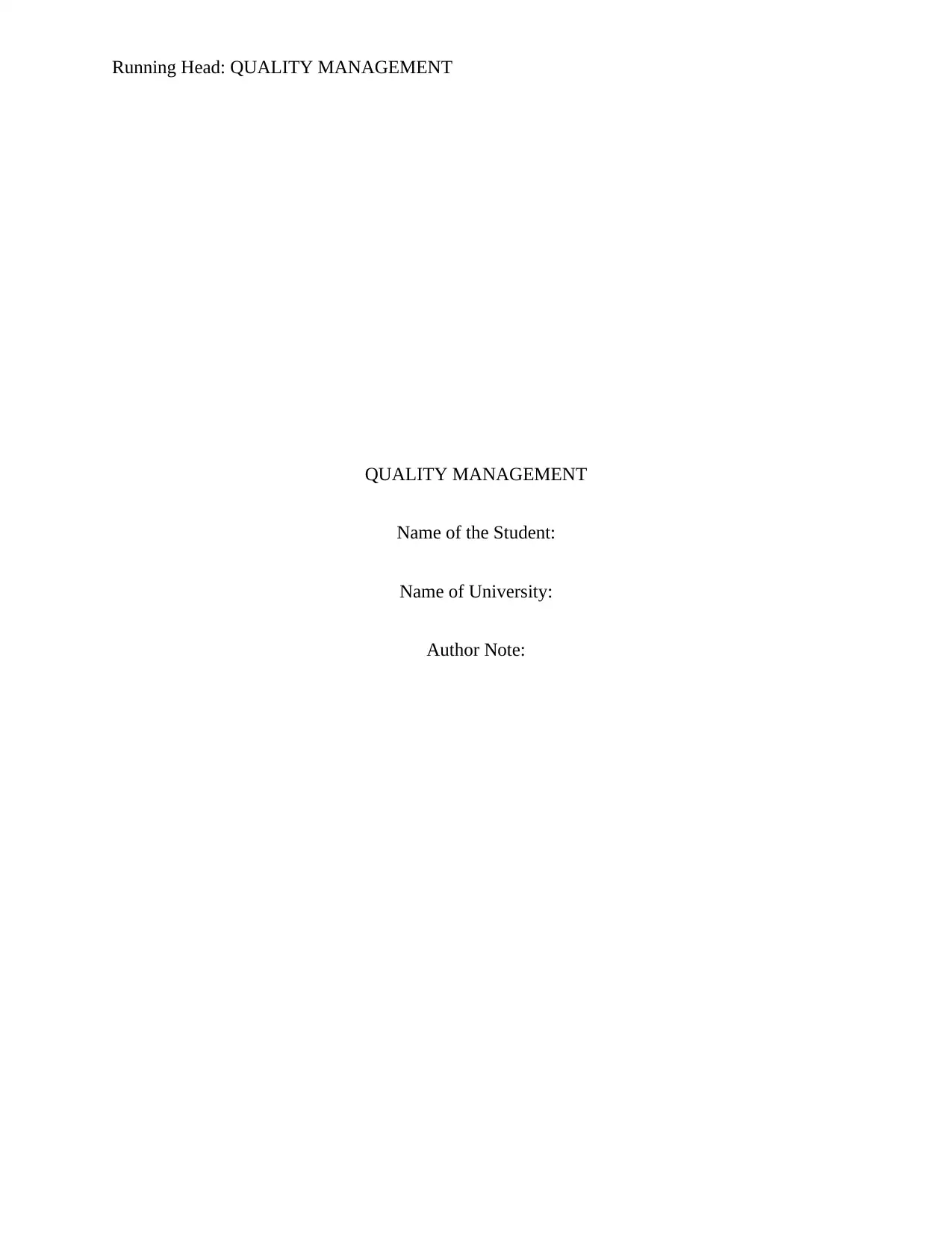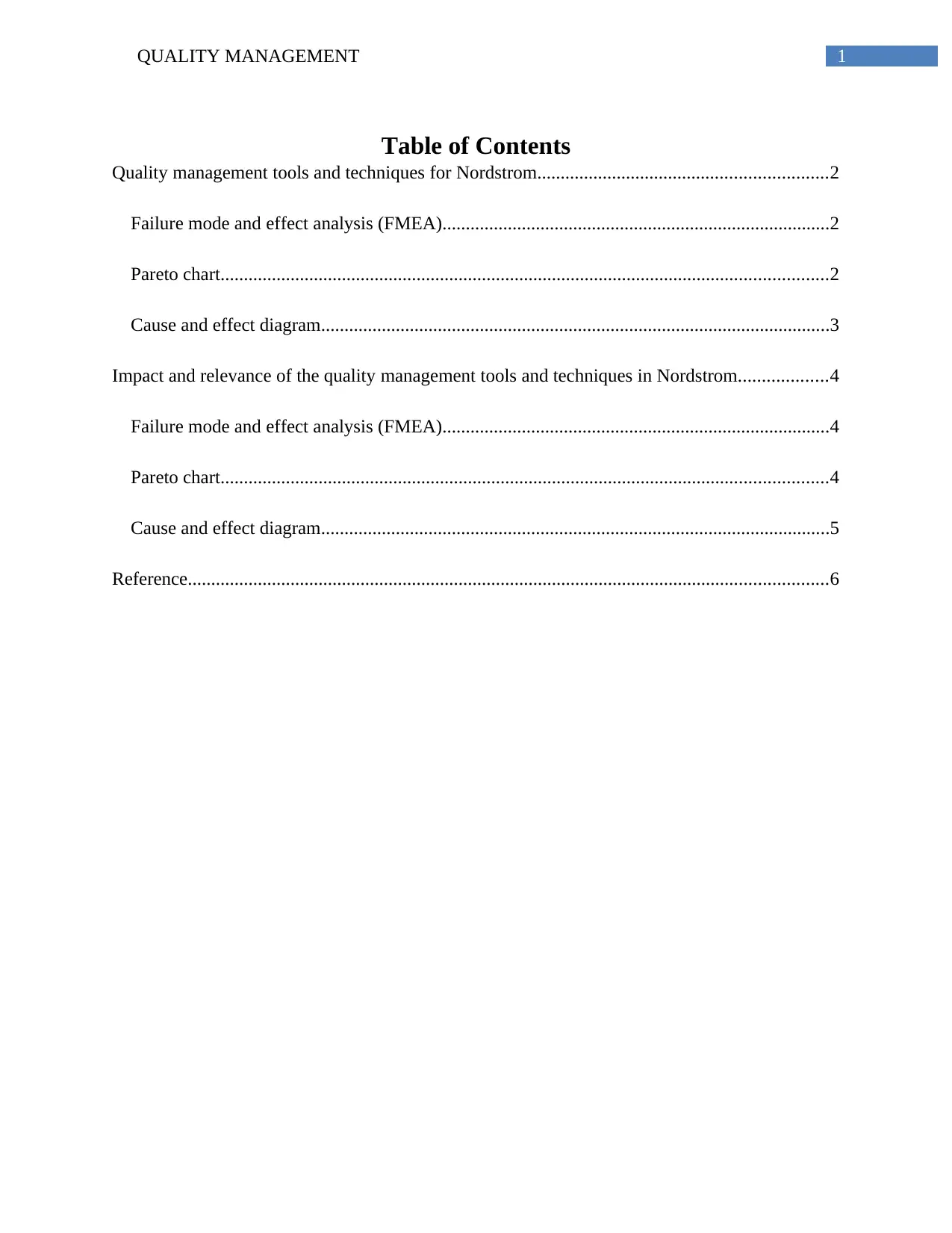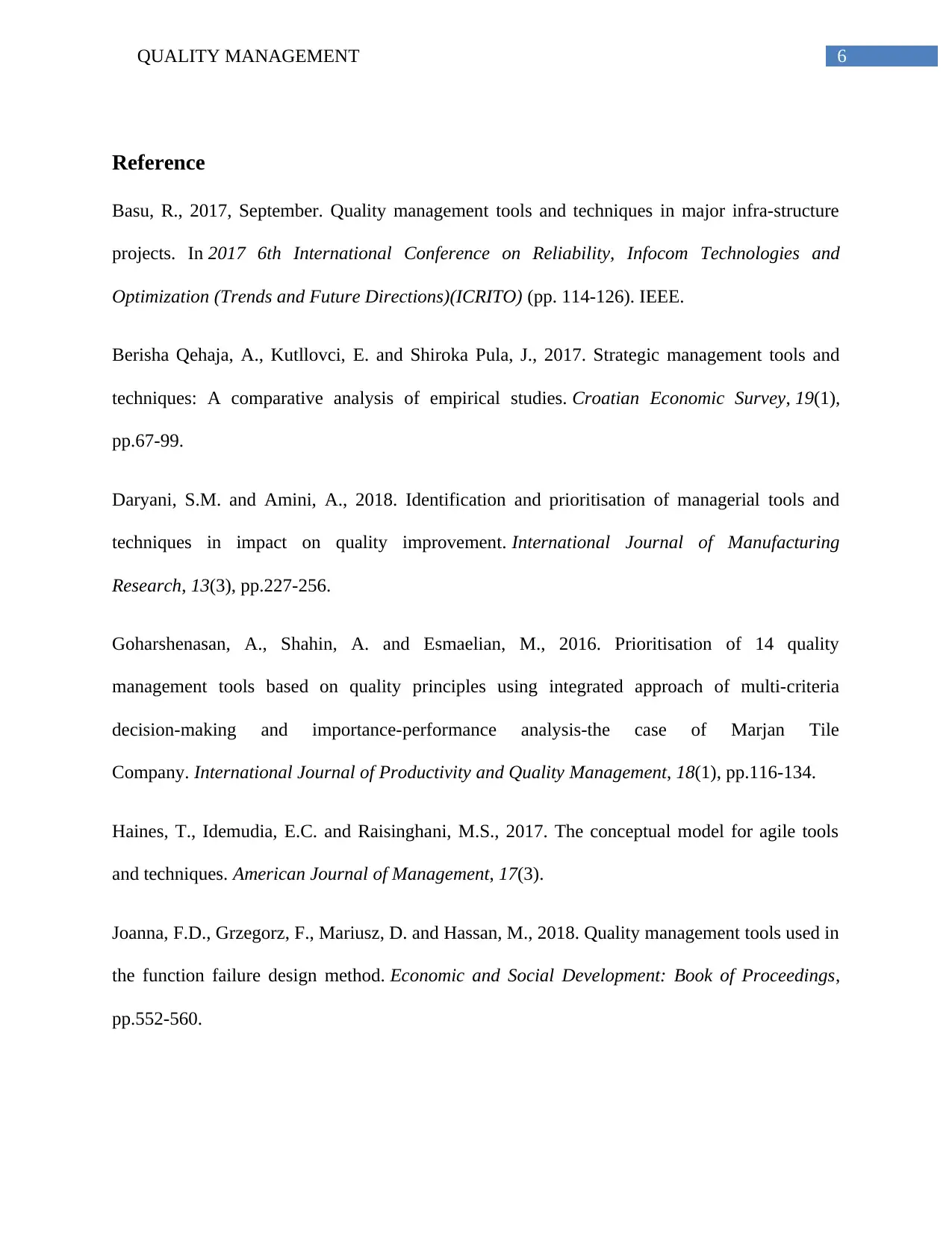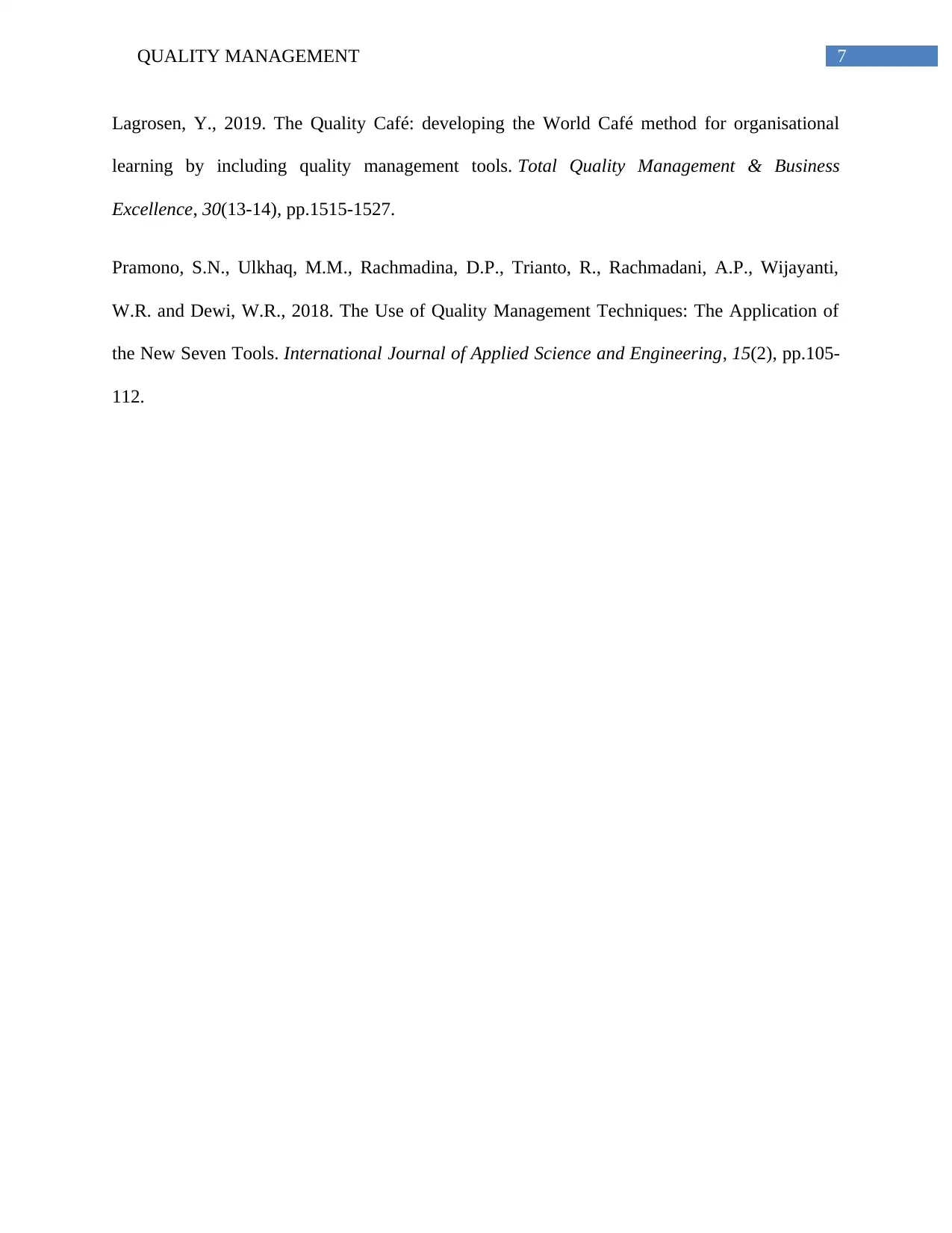Quality Management: Tools and Techniques for Nordstrom Analysis
VerifiedAdded on 2022/09/27
|8
|1555
|32
Report
AI Summary
This report provides an analysis of quality management tools and techniques applicable to Nordstrom, a fashion specialty retailer. It examines the Failure Mode and Effect Analysis (FMEA), Pareto charts, and cause-and-effect diagrams as key tools for improving quality within the company's operations. The report discusses how FMEA can help identify and categorize product failures, while Pareto charts are used to pinpoint frequent defects and other quality-related issues. Cause-and-effect diagrams, also known as Ishikawa diagrams, are explored for identifying and displaying possible causes of quality problems. The impact and relevance of these tools within Nordstrom are also discussed, highlighting how they can be used to monitor quality, prioritize issues, and develop effective mitigation plans. The report emphasizes the importance of these tools in ensuring product and service quality, improving processes, and achieving business objectives. The report also includes references to support the analysis.

Running Head: QUALITY MANAGEMENT
QUALITY MANAGEMENT
Name of the Student:
Name of University:
Author Note:
QUALITY MANAGEMENT
Name of the Student:
Name of University:
Author Note:
Paraphrase This Document
Need a fresh take? Get an instant paraphrase of this document with our AI Paraphraser

1QUALITY MANAGEMENT
Table of Contents
Quality management tools and techniques for Nordstrom..............................................................2
Failure mode and effect analysis (FMEA)...................................................................................2
Pareto chart..................................................................................................................................2
Cause and effect diagram.............................................................................................................3
Impact and relevance of the quality management tools and techniques in Nordstrom...................4
Failure mode and effect analysis (FMEA)...................................................................................4
Pareto chart..................................................................................................................................4
Cause and effect diagram.............................................................................................................5
Reference.........................................................................................................................................6
Table of Contents
Quality management tools and techniques for Nordstrom..............................................................2
Failure mode and effect analysis (FMEA)...................................................................................2
Pareto chart..................................................................................................................................2
Cause and effect diagram.............................................................................................................3
Impact and relevance of the quality management tools and techniques in Nordstrom...................4
Failure mode and effect analysis (FMEA)...................................................................................4
Pareto chart..................................................................................................................................4
Cause and effect diagram.............................................................................................................5
Reference.........................................................................................................................................6

2QUALITY MANAGEMENT
Quality management tools and techniques for Nordstrom
There are several potential tool and techniques that are available for Nordstrom and
improve the system and process in support of the business objectives.
Failure mode and effect analysis (FMEA)
According to the research of Basu (2017) the failure mode and effect analysis (FMEA) is
associated with the product development and operation management framework that will help to
manufacture products and deliver effective services. It is important to note that the FMEA tool
primarily focuses on the failure of the product and the factors responsible for the failure of the
product. Past experience of the same product failure is an important role to play in the process of
identifying and categorising the failures (Pramono et al 2018). Therefore, it is pertinent for the
operations to have a deep insights into the previous experiences and create a system that can
remove those failures. One of the major advantage of the FMEA tool is that it requires less time
and cost to resolve the issues and set a better quality management system for the benefit of the
organisation. Henceforth, the FMEA technique is widely used manufacturing industries and in
various product life cycle phase. The framework is relevant in the service industry quality
management practice as well.
Pareto chart
Pareto chart is a widely popular quality management tool that helps to find out the
frequent defects, complaints and other quality related issues that a manufacturing unit can face.
One of the major advantage of the Pareto chart is that it is a visual tool that can easily be
implemented (Goharshenasan et al. 2016). It performs on specific data sets that the professionals
can input related to the quality management problem. The professional can measure the
Quality management tools and techniques for Nordstrom
There are several potential tool and techniques that are available for Nordstrom and
improve the system and process in support of the business objectives.
Failure mode and effect analysis (FMEA)
According to the research of Basu (2017) the failure mode and effect analysis (FMEA) is
associated with the product development and operation management framework that will help to
manufacture products and deliver effective services. It is important to note that the FMEA tool
primarily focuses on the failure of the product and the factors responsible for the failure of the
product. Past experience of the same product failure is an important role to play in the process of
identifying and categorising the failures (Pramono et al 2018). Therefore, it is pertinent for the
operations to have a deep insights into the previous experiences and create a system that can
remove those failures. One of the major advantage of the FMEA tool is that it requires less time
and cost to resolve the issues and set a better quality management system for the benefit of the
organisation. Henceforth, the FMEA technique is widely used manufacturing industries and in
various product life cycle phase. The framework is relevant in the service industry quality
management practice as well.
Pareto chart
Pareto chart is a widely popular quality management tool that helps to find out the
frequent defects, complaints and other quality related issues that a manufacturing unit can face.
One of the major advantage of the Pareto chart is that it is a visual tool that can easily be
implemented (Goharshenasan et al. 2016). It performs on specific data sets that the professionals
can input related to the quality management problem. The professional can measure the
⊘ This is a preview!⊘
Do you want full access?
Subscribe today to unlock all pages.

Trusted by 1+ million students worldwide

3QUALITY MANAGEMENT
frequency of the problem and the wider causes that can foster problems in the quality of the
products. An effective communication within the operations department is also developed under
the rules of the Pareto chart (Haines et al. 2017). Therefore, it can be argues that the Pareto Chart
is very effective to maintain proper quality control of the product and also provides solutions to
eradicate the quality related issue permanently.
Cause and effect diagram
The cause and effect diagram is an effective tool to identify issues and display possible
causes of the issue. It is also known as the Ishikawa diagram. In the context of quality
management, cause and effect diagram is highly relevant as it creates a relationship between the
given cause and the factors influences the outcome (Berisha Qehaja et al. 2017). The depiction
of the root causes of a specific problem with a rational understanding is very effective to increase
the process knowledge and identify data that are associated with the cause and the effect of the
particular problem. In quality management, the cause and effective diagram can generate in-
depth analysis of the factors behind the cause of the quality related issue so that the operations
department will take necessary steps to resolve the issue as soon as possible (Lagrosen 2019).
Having a clear perception of the relevant causal factors, it does not take enough time for the
respective individual or the department to take proper action on quality enhancement.
frequency of the problem and the wider causes that can foster problems in the quality of the
products. An effective communication within the operations department is also developed under
the rules of the Pareto chart (Haines et al. 2017). Therefore, it can be argues that the Pareto Chart
is very effective to maintain proper quality control of the product and also provides solutions to
eradicate the quality related issue permanently.
Cause and effect diagram
The cause and effect diagram is an effective tool to identify issues and display possible
causes of the issue. It is also known as the Ishikawa diagram. In the context of quality
management, cause and effect diagram is highly relevant as it creates a relationship between the
given cause and the factors influences the outcome (Berisha Qehaja et al. 2017). The depiction
of the root causes of a specific problem with a rational understanding is very effective to increase
the process knowledge and identify data that are associated with the cause and the effect of the
particular problem. In quality management, the cause and effective diagram can generate in-
depth analysis of the factors behind the cause of the quality related issue so that the operations
department will take necessary steps to resolve the issue as soon as possible (Lagrosen 2019).
Having a clear perception of the relevant causal factors, it does not take enough time for the
respective individual or the department to take proper action on quality enhancement.
Paraphrase This Document
Need a fresh take? Get an instant paraphrase of this document with our AI Paraphraser

4QUALITY MANAGEMENT
Impact and relevance of the quality management tools and techniques in
Nordstrom
Failure mode and effect analysis (FMEA)
Failure and effect analysis is also a problem identification tool that can be helpful for
Nordstrom to find out the problems and take necessary steps. For Nordstrom, the quality of the
product and services is very important and the FMEA model will provide a continuous
monitoring process on the quality of manufacturing and services. As the FMEA model depends
on the past experience so that Nordstrom can measure the weightage of the problems by its
frequencies and consequences. It will provide a wider picture to Nordstrom to understand the
magnanimity of the problems and take necessary actions to resolve the quality related issues
(Joanna et al. 2018). The remedial actions provided by the Nordstrom are very pertinent to
provide cumulative impact on the life cycle consequences and Nordstrom will able to prioritise
the risks or challenges. As a result of that the company will able to prepare an effective
mitigation plan.
Pareto chart
The Pareto Chart is a very well structured quality management tool that not only
identifies the issues but also provide solution to mitigate the issue with proper timeframe. For
Nordstrom, it will be very effective to have an understanding of the required time and scheduling
of each of the mitigation steps. The first part of the Pareto chart is associated with establishing a
purpose of implementing the chart (Daryani et al. 2018). For Nordstrom, it will be effective to
set the goals and objectives of the plan so that it will help to guide to the further process.
Moreover, the Pareto Chart will help Nordstrom to figure out the most critical issues that has to
Impact and relevance of the quality management tools and techniques in
Nordstrom
Failure mode and effect analysis (FMEA)
Failure and effect analysis is also a problem identification tool that can be helpful for
Nordstrom to find out the problems and take necessary steps. For Nordstrom, the quality of the
product and services is very important and the FMEA model will provide a continuous
monitoring process on the quality of manufacturing and services. As the FMEA model depends
on the past experience so that Nordstrom can measure the weightage of the problems by its
frequencies and consequences. It will provide a wider picture to Nordstrom to understand the
magnanimity of the problems and take necessary actions to resolve the quality related issues
(Joanna et al. 2018). The remedial actions provided by the Nordstrom are very pertinent to
provide cumulative impact on the life cycle consequences and Nordstrom will able to prioritise
the risks or challenges. As a result of that the company will able to prepare an effective
mitigation plan.
Pareto chart
The Pareto Chart is a very well structured quality management tool that not only
identifies the issues but also provide solution to mitigate the issue with proper timeframe. For
Nordstrom, it will be very effective to have an understanding of the required time and scheduling
of each of the mitigation steps. The first part of the Pareto chart is associated with establishing a
purpose of implementing the chart (Daryani et al. 2018). For Nordstrom, it will be effective to
set the goals and objectives of the plan so that it will help to guide to the further process.
Moreover, the Pareto Chart will help Nordstrom to figure out the most critical issues that has to

5QUALITY MANAGEMENT
be resolved as soon as possible. As a result of that Nordstrom will able to prioritise its measures
accordingly and formulate a better quality management plan that can bring competitive
advantage to the organisation. The data analysis and chart development by Pareto chart quality
management tool will ease the effort for Nordstrom to gain long term benefits as well.
Cause and effect diagram
From the cause and effect diagram, Nordstrom can find out the relevant casual factors
that can create problem for the organisation in long term growth. As per the research of Basu
(2017) the cause and effect diagram follows a rational identification of the factors of the issue.
Therefore, in case of Nordstrom as well it will be effective to find out the potential causes that
can be a threat for the organisation. With the help of the cause and effect diagram Nordstrom can
find out the problems in each and every process of the manufacturing and service delivery. The
focus will be on the quality improvement of the products and services of Nordstrom. Therefore,
the cause and effect diagram will be very relevant for Nordstrom to identify the issues in every
department and ensure all those issues are properly identified and measured so that proper steps
can be taken to eradicate those issues as soon as possible.
be resolved as soon as possible. As a result of that Nordstrom will able to prioritise its measures
accordingly and formulate a better quality management plan that can bring competitive
advantage to the organisation. The data analysis and chart development by Pareto chart quality
management tool will ease the effort for Nordstrom to gain long term benefits as well.
Cause and effect diagram
From the cause and effect diagram, Nordstrom can find out the relevant casual factors
that can create problem for the organisation in long term growth. As per the research of Basu
(2017) the cause and effect diagram follows a rational identification of the factors of the issue.
Therefore, in case of Nordstrom as well it will be effective to find out the potential causes that
can be a threat for the organisation. With the help of the cause and effect diagram Nordstrom can
find out the problems in each and every process of the manufacturing and service delivery. The
focus will be on the quality improvement of the products and services of Nordstrom. Therefore,
the cause and effect diagram will be very relevant for Nordstrom to identify the issues in every
department and ensure all those issues are properly identified and measured so that proper steps
can be taken to eradicate those issues as soon as possible.
⊘ This is a preview!⊘
Do you want full access?
Subscribe today to unlock all pages.

Trusted by 1+ million students worldwide

6QUALITY MANAGEMENT
Reference
Basu, R., 2017, September. Quality management tools and techniques in major infra-structure
projects. In 2017 6th International Conference on Reliability, Infocom Technologies and
Optimization (Trends and Future Directions)(ICRITO) (pp. 114-126). IEEE.
Berisha Qehaja, A., Kutllovci, E. and Shiroka Pula, J., 2017. Strategic management tools and
techniques: A comparative analysis of empirical studies. Croatian Economic Survey, 19(1),
pp.67-99.
Daryani, S.M. and Amini, A., 2018. Identification and prioritisation of managerial tools and
techniques in impact on quality improvement. International Journal of Manufacturing
Research, 13(3), pp.227-256.
Goharshenasan, A., Shahin, A. and Esmaelian, M., 2016. Prioritisation of 14 quality
management tools based on quality principles using integrated approach of multi-criteria
decision-making and importance-performance analysis-the case of Marjan Tile
Company. International Journal of Productivity and Quality Management, 18(1), pp.116-134.
Haines, T., Idemudia, E.C. and Raisinghani, M.S., 2017. The conceptual model for agile tools
and techniques. American Journal of Management, 17(3).
Joanna, F.D., Grzegorz, F., Mariusz, D. and Hassan, M., 2018. Quality management tools used in
the function failure design method. Economic and Social Development: Book of Proceedings,
pp.552-560.
Reference
Basu, R., 2017, September. Quality management tools and techniques in major infra-structure
projects. In 2017 6th International Conference on Reliability, Infocom Technologies and
Optimization (Trends and Future Directions)(ICRITO) (pp. 114-126). IEEE.
Berisha Qehaja, A., Kutllovci, E. and Shiroka Pula, J., 2017. Strategic management tools and
techniques: A comparative analysis of empirical studies. Croatian Economic Survey, 19(1),
pp.67-99.
Daryani, S.M. and Amini, A., 2018. Identification and prioritisation of managerial tools and
techniques in impact on quality improvement. International Journal of Manufacturing
Research, 13(3), pp.227-256.
Goharshenasan, A., Shahin, A. and Esmaelian, M., 2016. Prioritisation of 14 quality
management tools based on quality principles using integrated approach of multi-criteria
decision-making and importance-performance analysis-the case of Marjan Tile
Company. International Journal of Productivity and Quality Management, 18(1), pp.116-134.
Haines, T., Idemudia, E.C. and Raisinghani, M.S., 2017. The conceptual model for agile tools
and techniques. American Journal of Management, 17(3).
Joanna, F.D., Grzegorz, F., Mariusz, D. and Hassan, M., 2018. Quality management tools used in
the function failure design method. Economic and Social Development: Book of Proceedings,
pp.552-560.
Paraphrase This Document
Need a fresh take? Get an instant paraphrase of this document with our AI Paraphraser

7QUALITY MANAGEMENT
Lagrosen, Y., 2019. The Quality Café: developing the World Café method for organisational
learning by including quality management tools. Total Quality Management & Business
Excellence, 30(13-14), pp.1515-1527.
Pramono, S.N., Ulkhaq, M.M., Rachmadina, D.P., Trianto, R., Rachmadani, A.P., Wijayanti,
W.R. and Dewi, W.R., 2018. The Use of Quality Management Techniques: The Application of
the New Seven Tools. International Journal of Applied Science and Engineering, 15(2), pp.105-
112.
Lagrosen, Y., 2019. The Quality Café: developing the World Café method for organisational
learning by including quality management tools. Total Quality Management & Business
Excellence, 30(13-14), pp.1515-1527.
Pramono, S.N., Ulkhaq, M.M., Rachmadina, D.P., Trianto, R., Rachmadani, A.P., Wijayanti,
W.R. and Dewi, W.R., 2018. The Use of Quality Management Techniques: The Application of
the New Seven Tools. International Journal of Applied Science and Engineering, 15(2), pp.105-
112.
1 out of 8
Related Documents
Your All-in-One AI-Powered Toolkit for Academic Success.
+13062052269
info@desklib.com
Available 24*7 on WhatsApp / Email
![[object Object]](/_next/static/media/star-bottom.7253800d.svg)
Unlock your academic potential
Copyright © 2020–2025 A2Z Services. All Rights Reserved. Developed and managed by ZUCOL.





